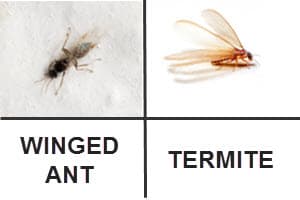How to Tell the Difference between a Winged Ant and Swarming Termite
 As the weather warms with the arrival of spring, it brings with it the emergence of many different insects. This includes swarming termites which are usually not very welcome house guests for many homeowners. However, flying ants and flying termites look very similar and are often confused. It is easy to mistake one for the other; so, knowing the differences between winged ants and swarming termites is important because one is a nuisance but the other will cost you.
As the weather warms with the arrival of spring, it brings with it the emergence of many different insects. This includes swarming termites which are usually not very welcome house guests for many homeowners. However, flying ants and flying termites look very similar and are often confused. It is easy to mistake one for the other; so, knowing the differences between winged ants and swarming termites is important because one is a nuisance but the other will cost you.
Distinctive Differences between Winged Ants and Swarming Termites
At first glance winged termites and winged ants look almost identical. Upon closer inspection there are some very distinctive differences. Both insects are about the same size, but the ant has a pinched waist, while the termite has a thick waist. You can clearly see the segments of the ant’s body but you cannot see the segments of the termite’s body.
Other areas of winged ant and swarming termite differences include the wings and the antennae. Both insects have two sets of wings, but while the termite’s wings are of equal length, the ant’s are not. The front set of wings is almost twice as long as the rear set.
What does it mean if you see swarming termites in your house?
If you see swarming insects in your home and you determine that they are termites, then it is very likely that you have a termite problem and should call a pest control professional immediately. Termites can do thousands of dollars of damage to a home, so you can’t afford to leave anything to chance.
Certain species of subterranean termites, like the Formosan, can do serious structural damage, feeding on the wooden portions of a house like the door frames, window frames, baseboards, and the wooden frame of the house. They can get in the walls, eating the drywall and the wooden support beams.
Why do ants and termites swarm?
Ants and termites swarm for the same reason: to start new colonies. Some species of termites have extremely large colonies. It’s not uncommon for members of a termite colony to forage 100 yards (the size of a football field) or more in search of food (wood), and their numbers can reach the millions! Keep this in mind the next time your neighbor is treating their home for termites. If your neighbor has them, chances are good that you do too. That isn’t always the case, but you should still have your home treated for termites to be on the safe side.
If you believe you have seen termites in your home and you still aren’t sure exactly how to tell the difference between a winged ant and swarming termite, call North Fulton Pest Solutions. One of our experienced, trained technicians will inspect your property and treat it for termites. Whether you are treating a termite infestation or you just want to take preventative measures to guard against termites, we are here to help.